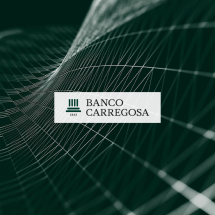- The Bank
- People
- All Services
- Private Banking
- Savings and Investment
- GoBulling Platforms
- Institutional and Corporate
- Insights
- Login My.BancoCarregosa
- Contacts
Enter your Username to gain access to your Bank. Complete your authentication on the next screen.
If you are not yet a client, open your account here or contact us for more information
Forms of long-term investment

Time is an investor's greatest ally. But turning on autopilot is not enough to benefit from long-term investing. Find out how to achieve it.
Long-term investment is one of the best ways to ensure a sustainable financial future. With the economy still recovering after the Covid-19 pandemic, the effects of the war in Ukraine, and the volatility expected for the foreseeable future, it is more important than ever to prioritise long-term investments and follow a coherent strategy.
Why invest for the long term
Many investors still see the stock market as an opportunity to generate quick, short-term gains. This may be the case in individual cases, but building wealth in a sustainable way requires thinking and investing for the long term.
The main advantage of investing for the long term is the reduction in risk. Holding investments for longer allows you to weather the ups and downs of the market. For example, although the S&P 500 index has a great track record, profitability varies over time and in any short period the index can fall substantially.
Thinking long-term also pays off in profitability. As the portfolio has more time to recover from market volatilities, investors can be more aggressive in their risk exposure. This, in principle, will be reflected in a higher return.
To reap these benefits, investors who invest their money must be able to keep it for at least five years, and the longer the better.
Anyone looking to invest for the long term should bear in mind the following premises.
5 premises for long-term investment
Today, there are different ways to invest, depending on your wealth growth objectives and desired level of risk. But whatever the instrument selected – from bonds, to funds, to precious metals and many other options – there are some good practices that should always be kept in mind.
1. Define a time horizon
All investors have different goals: it could be retirement, paying for your children's education, or covering the down payment on a house. A time horizon is associated with each goal. Long-term investment usually means five years or more, but there is no exact definition. Knowing when you will need the funds will give you a better idea of the right investments and the level of risk you should take.
2. Choose a strategy and follow it
Once you have established your investment objectives and time horizon, choose an investment strategy and stay on track. It may even be useful to divide the time horizon into segments, to guide asset allocation.
For example, imagine you are considering a long-term operation. You can create 3 time segments: the first 5 to 15 years, 15 to 30 years and 30 years onwards. Then you can set the rule that the shorter positions should be more conservative, with portfolios not including more thn 50% in equities. In the longer segment you can be more aggressive - with a portfolio consisting of 80% equities, for example.
It is especially important to choose a portfolio of assets with which you feel comfortable, to be sure you will follow the strategy. In particular, in the case of a market downturn, you’ll feel more anxious about the portfolio's performance. But it is precisely at these times that it is important to resist the temptation to sell and hold assets to generate long-term profitability.
3. Anticipating risks
To avoid automatic reactions to market falls, make sure you know the risks inherent to investing in different assets before you buy them.
Stocks are usually considered riskier investments than bonds and many managers suggest reducing exposure to these types of assets as the time horizon approaches. But even within the equity category, some investments are riskier than others. For example, US stocks are considered safer than those of countries with emerging economies because of the economic and political uncertainties associated with those regions.
On the other hand, bonds may be less risky, but they are not 100% safe. For example, bonds are only as safe as the issuer's bottom line. If the company goes bankrupt, it may not be able to pay its debts, and bondholders could lose some or all of their investment. To minimise this risk, you should invest in bonds of companies with good credit ratings. Remember that even these can underperform at times.
To help you manage risk, our Investment Management team monitors macroeconomic trends and the performance of different asset classes. See our investment approach here.
4. Diversify your portfolio
Spreading your portfolio across different types of assets allows you to protect your investments and increases the chances of having a winning position at any time over a long investment period.
One way to diversify a portfolio is through uncorrelated assets, i.e. assets with little tendency to move in the same direction. An example often looked at is that of gold and equities. As the stock market loses, gold, a safe haven asset, tends to increase in value. By buying uncorrelated assets that tend to behave differently you are diversifying your portfolio.
5. Review the strategy regularly
Even if you are committed to following an investment strategy, you still need to check performance and make adjustments. At Banco Carregosa, our team monitors portfolios with clients, analysing the underlying assets periodically.
Now that we've covered the best practices of long-term investing, let's look at some of the recommended vehicles for the times ahead.
Long-term investment vehicles
Long-term investment means purchasing positions, which may or may not be financial. From real estate to funds, discover some examples of how to build a portfolio for the coming years or decades.
1. Real estate
Real estate can be an option for both the active investor and for those looking for a passive income, without having to engage in these investments regularly until the time comes to sell it. This is one of the most common investments in Portugal in the form of flats, houses or warehouses to rent.Alternatively, you can get exposure to the property market by buying a stake in a fund. The VIP Fund, established in 1987, is an open-ended property investment fund with income distribution. It provides an investment opportunity in a diversified portfolio of assets that are attractive in terms of demand and appreciation.
2. Gold
After a decade above US$1,000 per ounce, gold prices increased by 40% during the pandemic, a further proof that this precious metal is still an excellent safe haven value. But not all investors know that exposure to gold can be achieved in different ways.Besides the traditional gold bars, you can also buy shares in funds of gold-related companies, such as mining companies or ETFs (Exchange Traded Funds). Similarly to Investment Funds, ETFs allow you to diversify your exposure and are listed and traded on the stock exchange.3. Equity funds
A stock fund is a possibility for those looking for a more aggressive long-term investment vehicle, but don't have the time or inclination to devote too much of their time to it.When you buy a stock fund, you get the weighted average return of all the companies in the fund, rather than being dependent on the performance of an individual security. For those who want to avoid looking at individual stocks, a stock fund – either an ETF or a mutual fund – can be a great long-term investment option.For example, some investors choose to buy holdings in a fund indexed to the S&P 500 or Nasdaq-100 indices. Why? To have access to a diversified and safer number of companies with just one position than they would if they owned just a few individual stocks.However, not all equity funds offer the same degree of diversification. Funds based on one industry, for example, are less diversified than others based on a broad index such as the S&P 500. A fund based on the automotive industry may be heavily exposed to oil prices and if prices for this commodity rise, many stocks in the fund are likely to suffer.4. Management models
In Banco Carregosa, we offer our clients the possibility of contracting management mandates. These are financial investment solutions adapted to the type of assets or investment profile of each client, in order to obtain the best return/risk rate.There are two types of management models: by asset class or by investment profile.
Asset class management models are designed with the type of assets of each client in mind:
• Bonds. A portfolio composed exclusively of bonds to generate long-term returns and reduce exposure to risk.
• Alpha Valor. Investment made by combining various alternative strategies that aim at mitigating risk by significantly diversifying investments.
• Large Capitalisation. Long-term investment in shares of global company with continuous risk management.
• Active Value. A portfolio of shares selected for their potential and high profitability, to maximise portfolio returns.
Management models by investment profile, on the other hand, depend essentially on exposure to risk and desired returns:
• Preservation. Focus on capital preservation. Conservative approach in the selection of the assets that make up the portfolio.
• Capitalisation. Seeks long-term capital appreciation by balancing risk and return.
• Appreciation. Its main objective is capital appreciation and its secondary objective is preservation.
• Aggressive appreciation. Portfolio with significant exposure to assets with high return potential.
In short, time is an investor's greatest ally. But turning on autopilot is not enough to benefit from long-term investing. You need to have clear objectives, as well as a defined horizon and an investment strategy, and know how to stay on track.
Investors have various vehicles at their disposal to help them achieve these goals: from real estate, gold, investment funds or through management mandates. Overall, long-term investing means focusing on financial objectives and ignoring the ongoing buzz. Contact our team to find out how to go about it.
Click here for additional Legal Information.



















